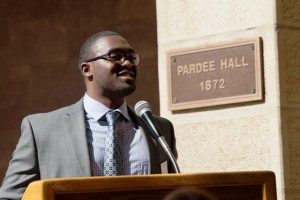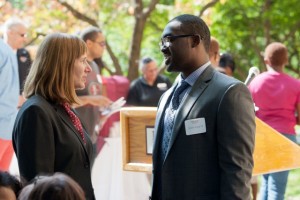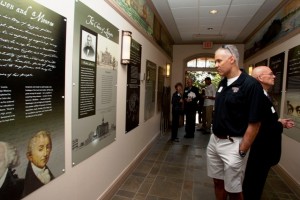By Sean Grim ’14
Twenty-seven years before the passage of the 13th Amendment, two slaves were admitted to Lafayette College. One went on to become a physician in New York City, while the other took up missionary work in Liberia. These young men, David and Washington McDonogh, were two of the 10 African-Americans who matriculated at Lafayette between 1832 and 1846.

Robert Young ’14 speaks at the exhibit-opening reception.
Yet despite the triumphs of these men, Lafayette would not admit another black student for the next hundred years.
In recent decades, Lafayette has made a conscious effort to increase diversity in the student body and curriculum. In the stories of David and Washington McDonogh, Robert Young ’14 (Washington, D.C.) saw the opportunity to demonstrate that this is a return to the College’s pioneering roots. Young teamed up with Diane Shaw, College archivist and director of Special Collections, to create an exhibit dedicated to the achievements of these first African-American students, Tales of Our Brothers: The Journey of David and Washington McDonogh.
View images from the exhibit reception on Flickr
Located inside the south entrance of Pardee Hall, the exhibit was unveiled to President Alison Byerly and the Board of Trustees in a ceremony during Homecoming. Young, the curator of the exhibit, made the decision to house the display in Pardee rather than the Portlock Black Cultural Center, the traditional venue for African-American exhibitions. When asked why, his answer was simple: “It’s not African-American history. It’s Lafayette history.”
For the three months leading up to the unveiling ceremony, Young and Shaw worked to craft a compelling narrative for the exhibit. Shaw introduced Young to the archival materials about the McDonoghs. With help from EXCEL Scholar Ng’ang’a Muchiri ’09, Shaw had transcribed much of their correspondence.

President Alison Byerly speaks with Robert Young ’14 during the reception.
From this wealth of information, Young drew the inspiring vignettes that would form the foundation of the exhibit. The story is laid out on individual panels, each featuring an anecdote from the McDonoghs’ lives. Shaw composed the text, while designer Heather Reinert was brought in to produce the panels, integrating period artwork with the stylized text.
But, according to Shaw, it was Young who drove the project: “None of this would have happened without Rob Young—it was his idea and his vision that the McDonogh story should be told publicly in this way,” she says. “Rob was remarkable in gathering campus support for the project. It was wonderful to have his enthusiasm and sense of the importance of this story.”
For Young, a film & media studies and women’s and gender studies double major, the project is not yet complete. His ultimate goal is to integrate the McDonogh narrative into the Lafayette curriculum. Wendy Wilson-Fall, associate professor and chair of Africana Studies, already incorporates the McDonogh story into her Black Experience course, in which her students read the McDonoghs’ letters. Young hopes to parlay Wilson-Fall’s work into a First-Year Seminar, in which first-year students learn the pioneering legacy of their new community.
A Short History of the McDonoghs
David and Washington McDonogh were born into slavery on the Louisiana plantation of John McDonogh. A fervent proponent of colonization, John intended to gradually emancipate his slaves and send them to Liberia. He determined to send “two slaves of great promise,” David and Washington, north for further education, so that they could be missionaries upon arrival in Liberia. Through colleagues in the Presbyterian Church, which supported colonization, McDonogh contracted to send David and Washington to Lafayette in fall 1838.

Carl St. Bernard ’86 reads wall panels at the exhibit opening in Pardee Hall.
Once the McDonoghs arrived in Easton, their Presbyterian guardian set them free, putting them on equal footing with the rest of the students. Yet, as David would ruefully note, the College “expects of me the same responsibilities as every student, without any of the same privileges.” The McDonoghs, though no longer slaves, were completely segregated; they had separate classes, living quarters, and dining facilities. David studied Latin, Greek, calculus, chemistry, theology, anatomy, and surgery. In particular, he was fascinated with medicine, professing to his guardian that he would sacrifice anything rather than give up his medical studies.
In 1842, when John McDonogh ordered the McDonoghs to Liberia, Washington dutifully obeyed, joining his mother and other siblings from the McDonogh plantation on the journey; David refused to leave without his degree. Despite his ensuing estrangement from John McDonogh, David graduated from Lafayette in 1844, the first black graduate. Armed with his Lafayette diploma and experience as an apprentice with a local physician, he found a mentor at the College of Physicians and Surgeons in New York (now Columbia Medical School), who arranged for him to attend medical classes. David was not granted a degree; nonetheless, he was treated as a peer by other doctors, and received an appointment to the New York Eye and Ear Infirmary. In 1875, Eclectic Medical College of New York granted a medical degree to David and offered him a position in its faculty. In his last will and testament, David listed Lafayette College as a beneficiary, a final gesture of thanks to an institution where he had been emancipated in both body and mind.



5 Comments
The rich and dramatic saga of the McDonogh brothers is certainly more than worthy of its telling, and of continued research into their lives as slaves and as free men adjusting to a world and a country that did not want them. As Americans, we are all especially enriched by the clarity the story presents as to what it meant, and what it means, to be an American.
I am convinced, however, that the headline writer did not experience the exhibit, and if so, did not read it. Lafayette was Pioneering?? The text of the exhibit makes it quite clear that Lafayette College did as little as possible as an institution to ease the transition of these brave young men into the demands of the foreign and white academic world. The College permitted all of the segregated and unequal treatment, and the McDonogh brothers felt the pain from the wounds deeply. Lafayette was so proud of its “Pioneering” work with the McDonogh’s that it would be another 100 years, a shameful century, before it would enroll and graduate another African-American student. I knew him well, and read his Memorial Resolution at the Meeting of the Board of Trustees at the time of his death. His name was Roland Brown, Class of 1949. My voice cracked with emotion as I paused to read “100 years.” Please editors, do not gild the sordid facts; they are in fact sordid and the gilding cheapens the entire enterprise. It also insults the intelligence of those of us who know better, and have worked hard to make the critical improvements.
Sincerely,
Riley K. Temple, ’71, H ’09
Congratulations! This is remarkable that you are leading projects that are educating people of how the past contributed to today. Keep up the good work.
Wow! It’s always great to recognize and appreciate an important piece of history. It is definitely inspiring to see what strong will and dedication can accomplish. I’m confident that if you stay strong in your pursuit, you will have no problem adding this great piece of Lafayette’s history to the curriculum. Excellent job to everyone who came together to make this possible.
This is so awesome! Great job and so very proud of you and all of your accomplishments. Hopefully one day I am able to make it there to see it for myself. The pictures speak volumes but I am sure to see it in person would be phenomenal. Keep up the good work!!!
Wow…Special thanks to you and your team for the wonderful job you did on the “Tales of Our Brothers” Project. I was not there for the actual presentation at Lafayette’s Homecoming but I was able to visit shortly after. The exhibit display located in Pardee Hall was tremendous and very well represented. The extra time and effort you put in were certainly worthwhile in acknowledging the history of Lafayette College that had been untold until now. Excellent Job and Great Work!!!
Comments are closed.